
|
A starboard box view of WHITBY. M.D. Thomas photo. |
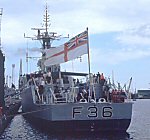
|
A stern view of WHITBY, showing the low quarterdeck and twin Limbo mounts.
The Limbo ASW mortars could train to either side of the ship. M.D.
Thomas photo.
|

|
TORQUAY. M.D. Thomas photo.
|

|
A starboard bow view of TORQUAY. This shows the older Type 275 tracker mounted
on the Type 6M fore control director located above the bridge, with the
Type 293 radar at the mast head. M.D. Thomas photo.
|

|
TENBY
laid up in South Wales just prior to scrapping. M.D. Thomas photo.
|

|
A broadside
view of ROTHESAY. Already refitted, she has the new helicopter deck and
hangar. M.D. Thomas photo.
|
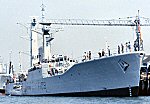
|
LONDONDERRY.
In this photo, her gun has been removed and a second mast added, during
her use as a trials ship. M.D. Thomas photo.
|

|
LONDONDERRY,
prior to her conversion to a trials ship. Her hangar is still present, with
the Seacat launcher mounted on top. M.D. Thomas photo.
|
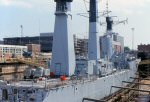
|
LONDONDERRY in
a graving dock. In this photo, her hangar has been stripped although the
landing deck markings are still visible. A third mast has been added where
the hangar used to be, but all armament has been removed. M.D. Thomas photo.
|

|
FALMOUTH. M.D.
Thomas photo.
|

|
FALMOUTH again,
presumably during her period as a harbour training ship. She appears to
have been stripped of all armaments and sensors. LONDONDERRY appears to
be in the background. M.D. Thomas photo.
|

|
YARMOUTH.
This photo of her amidships shows the superstructure arrangement to good
effect, and the placement of the various sensors. M.D. Thomas photo.
|
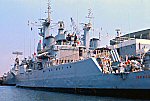
|
YARMOUTH again,
this time from the aft port quarter. Her Limbo mount is visible just aft
of the landing deck, and the Seacat launcher is visible on top of the hangar,
uncovered and trained slightly aft with four missiles mounted. M.D. Thomas
photo.
|

|
RHYL. M.D. Thomas
photo.
|

|
LOWESTOFT. M.D.
Thomas photo.
|
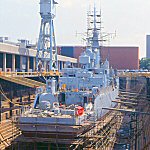
|
LOWESTOFT in a graving
dock. This photo will likely have been taken during her conversion to trial
the Type 2031 towed array sonar, which evidently necessitated the removal
of the Limbo mortar mount. The Seacat is still mounted atop the hangar,
but is covered. A deckhouse of some sort seems to be installed on the landing
deck, and a jack-post is also present there. M.D. Thomas photo.
|

|
PLYMOUTH. M.D. Thomas
photo.
|
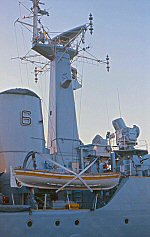
|
A good close-up
of PLYMOUTH's funnel, mast, and the newer MRS3 fire control director above
the bridge (to the right of the photo). M.D. Thomas photo.
|
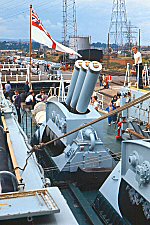
|
An early photo of
PLYMOUTH, prior to her refit to carry a helicopter. At this time, she carried
two Limbo mortars in a well aft of the superstructure. M.D. Thomas photo.
|
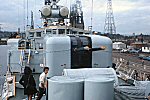
|
The 4.5" gun mounted
on PLYMOUTH's foc'st'le. M.D. Thomas photo.
|
PLYMOUTH
is now a museum ship in Birkenhead, near Liverpool, England. The following
photos were taken in 1999.
|
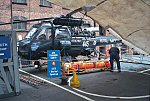
|
A Wasp light helicopter
on deck. The Wasp was used for anti-submarine as well as light utility duties.
For the former, she could carry two Mk.44 or Mk.46 torpedoes, an example
of which is on the deck beside the helicopter. Sandy McClearn photo.
|

|
The operations room
is set up as it might have appeared during action, under red-light conditions.
Sandy McClearn photo.
|
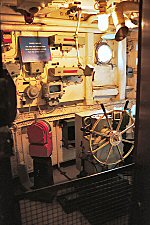
|
The wheelhouse on
PLYMOUTH is actually one deck below the bridge, at main deck level. A small
port is the only view the helmsman had to the outside view, and helm instructions
were piped down from the bridge. Sandy McClearn photo.
|
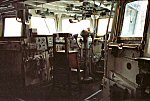
|
The interior of
the bridge, with the captain's position at the forward end in an alcove.
This provided the captain with a good view forward and to the sides of the
ship. Sandy McClearn photo.
|
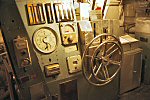
|
The port turbine
control in the main engine room. The large wheel controlled the main forward
turbine, while the inner wheel controlled the astern turbine. Also visible
is the port telegraph, the turbine RPM gauge, and Bailey tubes for monitoring
steam pressure and temperature in the turbines and boilers. The two
main turbines were located in the same compartment, with the boilers located
in a separate forward compartment. Sandy McClearn photo.
|
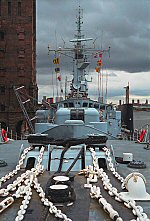
|
The view looking
aft from the bow. Sandy McClearn photo.
|
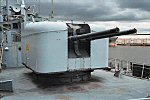
|
The 4.5"/45 Mk.6
Vickers twin gun. This gun could be used again both surface and airborne targets.
Sandy McClearn photo.
|
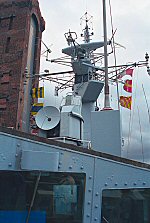
|
Looking aft and up from the port
bridge wing. In the foreground, above the bridge windows, is the MRS3 fire
control director with the Type 903 tracking radar mounted. Above this are
the navigation radar and the Type 994 radar antenna at the mast head. Sandy
McClearn photo.
|

|
The port bridge
wing, with a 20mm gun and a 8-barreled Corvus chaff launcher. Sandy McClearn
photo.
|
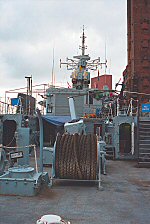
|
Looking forward
from the stern. The remaining Limbo mortar is visible, with the Wasp on
the landing deck forward. Sandy McClearn photo.
|
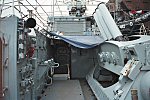
|
The Limbo mortar
mount, located in a well just aft of the landing deck. Originally there were
two of these mortars, but the forward mount was removed to make way for the
landing deck during the modernization of this class of ship. The Limbo could
train to either side of the ship to fire, and to reload would train down to
the port side where ammunition would be passed out through hatches in the
side of the well; these hatches can been seen to the left of the photo. Sandy
McClearn photo.
|
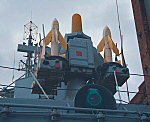
|
The Seacat launcher,
with dummy missiles mounted. Sandy McClearn photo.
|

